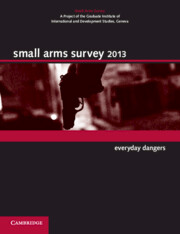Book contents
- Frontmatter
- Foreword
- Contents
- About the Small Arms Survey
- Notes to readers
- Acknowledgements
- Introduction
- Chapter 1 Everyday Dangers: Non-conflict Armed Violence
- Chapter 2 Too Close to Home: Guns and Intimate Partner Violence
- Chapter 3 Turning Points: Gang Evolution in Nicaragua
- Chapter 4 Guns in the Family: Mafia Violence in Italy
- Chapter 5 Survival at Stake: Violent Land Conflict in Africa
- Chapter 6 Trend Lines: Armed Violence in South Africa pages 132 to 137
- Chapter 6 Trend Lines: Armed Violence in South Africa pages 137 to 159
- Chapter 7 Second Wind: The PoA's 2012 Review Conference pages 160 to 168
- Chapter 7 Second Wind: The PoA's 2012 Review Conference pages 169 to 177
- Chapter 8 Trade Update: Authorized Small Arms Transfers
- Chapter 9 Burning the Bullet: Industrial Demilitarization of Ammunition pages 186 to 199
- Chapter 9 Burning the Bullet: Industrial Demilitarization of Ammunition pages 200 to 217
- Chapter 10 ‘Infernal Machines’: Improvised Explosive Devices
- Chapter 11 Price Watch: Arms and Ammunition at Illicit Markets pages 250 to 268
- Chapter 11 Price Watch: Arms and Ammunition at Illicit Markets pages 269 to 281
- Chapter 12 Captured and Counted: Illicit Weapons in Mexico and the Philippines pages 282 to 302
- Chapter 12 Captured and Counted: Illicit Weapons in Mexico and the Philippines pages 302 to 317
- Index
Chapter 5 - Survival at Stake: Violent Land Conflict in Africa
Published online by Cambridge University Press: 05 June 2014
- Frontmatter
- Foreword
- Contents
- About the Small Arms Survey
- Notes to readers
- Acknowledgements
- Introduction
- Chapter 1 Everyday Dangers: Non-conflict Armed Violence
- Chapter 2 Too Close to Home: Guns and Intimate Partner Violence
- Chapter 3 Turning Points: Gang Evolution in Nicaragua
- Chapter 4 Guns in the Family: Mafia Violence in Italy
- Chapter 5 Survival at Stake: Violent Land Conflict in Africa
- Chapter 6 Trend Lines: Armed Violence in South Africa pages 132 to 137
- Chapter 6 Trend Lines: Armed Violence in South Africa pages 137 to 159
- Chapter 7 Second Wind: The PoA's 2012 Review Conference pages 160 to 168
- Chapter 7 Second Wind: The PoA's 2012 Review Conference pages 169 to 177
- Chapter 8 Trade Update: Authorized Small Arms Transfers
- Chapter 9 Burning the Bullet: Industrial Demilitarization of Ammunition pages 186 to 199
- Chapter 9 Burning the Bullet: Industrial Demilitarization of Ammunition pages 200 to 217
- Chapter 10 ‘Infernal Machines’: Improvised Explosive Devices
- Chapter 11 Price Watch: Arms and Ammunition at Illicit Markets pages 250 to 268
- Chapter 11 Price Watch: Arms and Ammunition at Illicit Markets pages 269 to 281
- Chapter 12 Captured and Counted: Illicit Weapons in Mexico and the Philippines pages 282 to 302
- Chapter 12 Captured and Counted: Illicit Weapons in Mexico and the Philippines pages 302 to 317
- Index
Summary
INTRODUCTION
In Africa, land is not only an economic good, but also the very basis of security and survival for much of the population. A primary source of livelihood for many, land is not only directly linked to agriculture and production, but also intimately tied to the politics of the countries, the social dynamics of the people, and the status, power, wealth, and security of those who control it. Access to land increases security and reduces the vulnerability of the individual, the family, and the community. Yet competition for scarce resources, the political manipulation of access to land through ethnic, religious, and economic discrimination, and the forced removal of the poor from productive lands have sown the seeds of violence for decades. Violent land conflict—historically and today—revolves around questions of land use, land access, land ownership, and ultimately who benefits from the land and what it produces.
Examples of violent land conflict abound in Africa. Resource conflicts became the catch phrase of the 1990s, when civil wars erupted across the continent in places such as Angola, Côte d'Ivoire, the Democratic Republic of the Congo (DRC), Liberia, and Sierra Leone, fuelled by diamonds, timber, oil, and other natural resources (Klare, 2002). Resource conflicts are not always civil wars; they also include localized violence over particular resources, as in the Niger Delta, where armed clashes and kidnapping were commonplace in 2003–09, and in the Kivus of eastern DRC, where the most recent violence has involved the killing and raping of dozens of civilians, the forceful recruitment of hundreds, and the displacement of hundreds of thousands.
- Type
- Chapter
- Information
- Small Arms Survey 2013Everyday Dangers, pp. 102 - 131Publisher: Cambridge University PressPrint publication year: 2013



